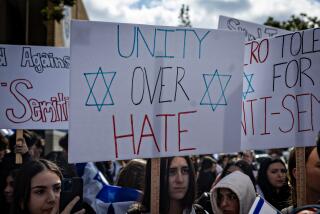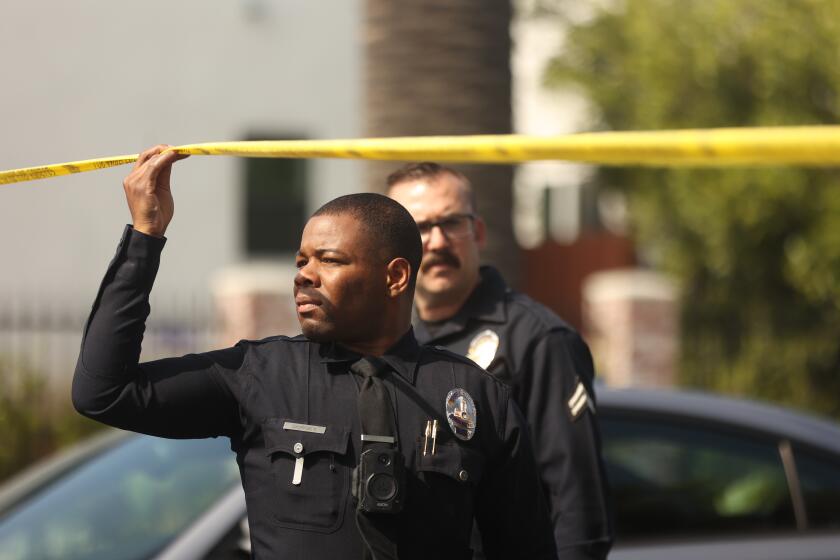Homicides don’t add up to a race war
- Share via
Racial tension between blacks and Latinos may be a fact of life in some Los Angeles neighborhoods. But racial violence isn’t.
Despite what you may have heard or read, it remains the case that the great majority of people who are murdered in the L.A. area are killed by someone of their own race.
This was the finding of a study by a team of UC Irvine scholars that was released earlier this year. It mirrored findings by The Times and accounts from detectives in the field. Last year, in the four Los Angeles police divisions with the highest homicide rates -- all places where blacks and Latinos share neighborhoods -- 90% of the homicides involved suspects and victims of the same race.
This year, a random sample of 212 homicides in Los Angeles, Inglewood, Long Beach and portions of L.A. County yielded a similar result: About 87% of Latinos and blacks who were killed were murdered by suspects of their own race.
The real news story is that there is no news story -- or at least no clear trend of cross-racial murders.
This is surprising. L.A.’s Latinos and blacks have ample opportunity to kill each other if they want to. In huge swaths of the county, they are integrated block by block, house by house. Many of the places with the highest homicide rates also have the greatest degree of racial mixing, with blacks and Latinos present in roughly equal numbers.
Take Watts. The neighborhood is split about 60% Latino, 40% black. But so far this year, just one of the area’s 37 killings is confirmed to have crossed racial lines. Why?
This is the kind of question that we don’t ask enough about homicide. Dazzled by trend stories, seduced by endless suggestions of some new menace on the horizon, we overlook the old boring truths that tell us the most. This one tells us that homicide is more about intimacy than it is about opportunity. Relationships and interdependence -- not just proximity -- are preconditions for its occurrence.
There are, of course, some purely predatory homicides. (A number of cross-racial killings this year, for example, have been robbery-murders.) But a majority of killings are less about predation than they are about people interacting
Most homicides involve the most basic human conflicts. Even the ones we call “gang homicides” tend to stem from arguments about women, money, insults, peer-group status, unredressed grief or business dealings gone wrong. There’s no more murderous situation than one that involves an attractive woman or a party. Homicide in L.A. remains primarily intra-racial because blacks and Latinos still tend to mostly mix with members of their own groups.
And when killings do cross racial lines, they often seem to suggest more about racial mingling than about racial hostility.
Yes, black and Latino gangs fight each other in some places in the county, and once in a while they even make ugly, racial comments about each other.
But there is also more to some killings than meets the eye. Consider the homicides of Shurnell West in the Hollenbeck Division and of Eugene “Shadow” Robinson in Rampart. Both black men had been welcomed into Latino gangs -- and got caught up in brown-on-brown gang fights. How do you classify that?
Other victims of recent cross-race killings were former friends, business partners or guests at the same parties, just as many victims of same-race killings were. In a few cases, they were, on closer inspection, of mixed Latino-black descent.
Too often we tell ourselves that homicide is a problem not of humanity but of inhumanity, and thus give ourselves some comforting distance from it. But distance doesn’t help us to understand the real question at the root of our homicide problem: Why do the same dynamics of conflict present among all humans everywhere play out in such lethal form among certain people, under certain conditions?
There is nothing wrong with paying attention to the marginal problem of black-Latino violence. But we need to keep our focus on the body count. The numbers tell a deeper story. Don’t neglect the victims of black-on-black and Latino-on-Latino violence just because they don’t make an exciting trend story. They are just as dead, and there are more of them.
More to Read
Sign up for Essential California
The most important California stories and recommendations in your inbox every morning.
You may occasionally receive promotional content from the Los Angeles Times.













